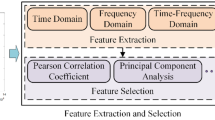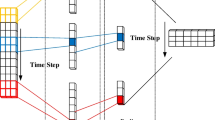Abstract
Machine health monitoring systems are vital components of modern manufacturing industries. As advanced sensors collecting machine health-related data become commonplace, such systems have started adopting data-driven approaches to harness the collected data. However, dealing with noisy data and gleaning the spatial and temporal correlation within the data is a challenge. Extant literature focuses on the use of feature extraction to judge the state of normal and worn tools. However, the process of detecting the features of worn tools can often damage the workpiece material and result in machine downtime, which increases costs. Using recent developments in artificial intelligence, data features can be used to gauge the condition of tools in real-time. This paper proposes Holistic–Local Long Short-Term Memory (HLLSTM), a deep learning approach that adopts Long Short-Term Memory to predict tool wear based on holistic and local features. The data is divided into segments to learn short-term data features and further divided into holistic training and local training data to extract more implicit feature information to improve the accuracy of tool wear prediction. Experimental results indicate that HLLSTM can reduce the mean absolute error of real tool wear value two-fold and accurately predict tool wear.


















Similar content being viewed by others
References
Lasi H, Fettke P, Kemper HG, Feld T, Hoffmann M (2014) Industry 4.0. Bus Inf Syst Eng 6(4):239–242
Lu Y, Xu X, Xu J (2014) Development of a hybrid manufacturing cloud. J Manufact Syst 33(4):551–566
Zhao R, Wang D, Yan R, Mao K, Shen F, Wang J (2017) Machine health monitoring using local feature-based gated recurrent unit networks. IEEE Trans Ind Electron 65(2):1539–1548
Qiao H, Wang T, Wang P, Qiao S, Zhang L (2018) A time-distributed spatiotemporal feature learning method for machine health monitoring with multi-sensor time series. Sensors 18(9):2932
Zhao R, Yan R, Chen Z, Mao K, Wang P, Gao RX (2019) Deep learning and its applications to machine health monitoring. Mech Syst Signal Process 115:213–237
Xu Y, Sun Y, Liu X, Zheng Y (2019) A digital-twin-assisted fault diagnosis using deep transfer learning. IEEE Access 7:19990–19999
Serin G, Sener B, Ozbayoglu AM, Unver HO (2020) Review of tool condition monitoring in machining and opportunities for deep learning. Int J Adv Manufact Technol. https://doi.org/10.1007/s00170-020-05449-w
He K, Zhang X, Ren S, Sun J (2016) Deep residual learning for image recognition. Proceedings of the IEEE Conference on Computer Vision and Pattern Recognition 770–778
Zhang HB, Zhang YX, Zhong B, Lei Q, Yang L, Du JX, Chen DS (2019) A comprehensive survey of vision-based human action recognition methods. Sensors 19(5):1005
Toshev A, Szegedy C (2014) Deeppose: Human pose estimation via deep neural networks. Proceedings of the IEEE Conference on Computer Vision and Pattern Recognition 1653–1660
Cao Z, Hidalgo G, Simon T, Wei SE, Sheikh Y (2018) OpenPose: realtime multi-person 2D pose estimation using Part Affinity Fields. arXiv preprint arXiv:1812.08008
Wang J, Ma Y, Zhang L, Gao RX, Wu D (2018) Deep learning for smart manufacturing: Methods and applications. J Manufact Syst 48:144–156
Tao F, Qi Q, Liu A, Kusiak A (2018) Data-driven smart manufacturing. J Manufact Syst 48:157–169
Hinton G, Deng L, Yu D, Dahl GE, Mohamed AR, Jaitly N, Kingsbury B (2012) Deep neural networks for acoustic modeling in speech recognition: The shared views of four research groups. IEEE Signal Process Mag 29(6):82–97
Liu W, Wang Z, Liu X, Zeng N, Liu Y, Alsaadi FE (2017) A survey of deep neural network architectures and their applications. Neurocomputing 234:11–26
Wang S, Cao J, Yu P (2020) Deep learning for spatio-temporal data mining: A survey. IEEE Transactions on Knowledge and Data Engineering
Cheng Y, Zhu H, Wu J, Shao X (2018) Machine health monitoring using adaptive kernel spectral clustering and deep long short-term memory recurrent neural networks. IEEE Trans Ind Inf 15(2):987–997
Essien A, Giannetti C (2020) A deep learning model for smart manufacturing using convolutional LSTM neural network autoencoders. IEEE Trans Ind Inf 16(9):6069–6078
Liu R, Meng G, Yang B, Sun C, Chen X (2016) Dislocated time series convolutional neural architecture: An intelligent fault diagnosis approach for electric machine. IEEE Trans Ind Inf 13(3):1310–1320
Lei Y, Han D, Lin J, He Z (2013) Planetary gearbox fault diagnosis using an adaptive stochastic resonance method. Mech Syst Signal Process 38(1):113–124
Krizhevsky A, Sutskever I, Hinton GE (2012) ImageNet classification with deep convolutional neural networks. Adv Neural Inf Process Syst 1:1097–1105
He K, Zhang X, Ren S, Sun J (2016) Deep Residual Learning for Image Recognition(CVPR). In Proceedings of the IEEE Conference on Computer Vision and Pattern Recognition, June, 2016
Hochreiter S, Schmidhuber J (1997) Long short-term memory. Neural Comput 9(8):1735–1780
Lample G, Ballesteros M, Subramanian S, Kawakami K, Dyer C (2016) Neural Architectures for Named Entity Recognition. In Proceedings of NAACL-HLT, June 2016
Mousa AED, Schuller BW (2016) Deep Bidirectional Long Short-Term Memory Recurrent Neural Networks for Grapheme-to-Phoneme Conversion Utilizing Complex Many-to-Many Alignments. Interspeech 2836–2840
Bengio Y (2009) Learning deep architectures for AI. Found Trends Mach Learn 2(1):1–127
Ray A, Rajeswar S, Chaudhury S (2015) Text recognition using deep BLSTM networks. In Proc. of 2015 Eighth International Conference on Advances in Pattern Recognition (ICAPR), pp. 1-6
Zhao R, Yan R, Wang J, Mao K (2017) Learning to monitor machine health with convolutional bi-directional LSTM networks. Sensors 17(2):273
Srivastava N, Hinton G, Krizhevsky A, Sutskever I, Salakhutdinov R (2014) Dropout: a simple way to prevent neural networks from overfitting. J Mach Learn Res 15(1):1929–1958
2010 phm Society Conference Data Challenge(2010). https://phmsociety.org/competition/phm/10
Author information
Authors and Affiliations
Corresponding author
Additional information
Publisher's Note
Springer Nature remains neutral with regard to jurisdictional claims in published maps and institutional affiliations.
Rights and permissions
About this article
Cite this article
Chan, YW., Kang, TC., Yang, CT. et al. Tool wear prediction using convolutional bidirectional LSTM networks. J Supercomput 78, 810–832 (2022). https://doi.org/10.1007/s11227-021-03903-4
Accepted:
Published:
Issue Date:
DOI: https://doi.org/10.1007/s11227-021-03903-4




